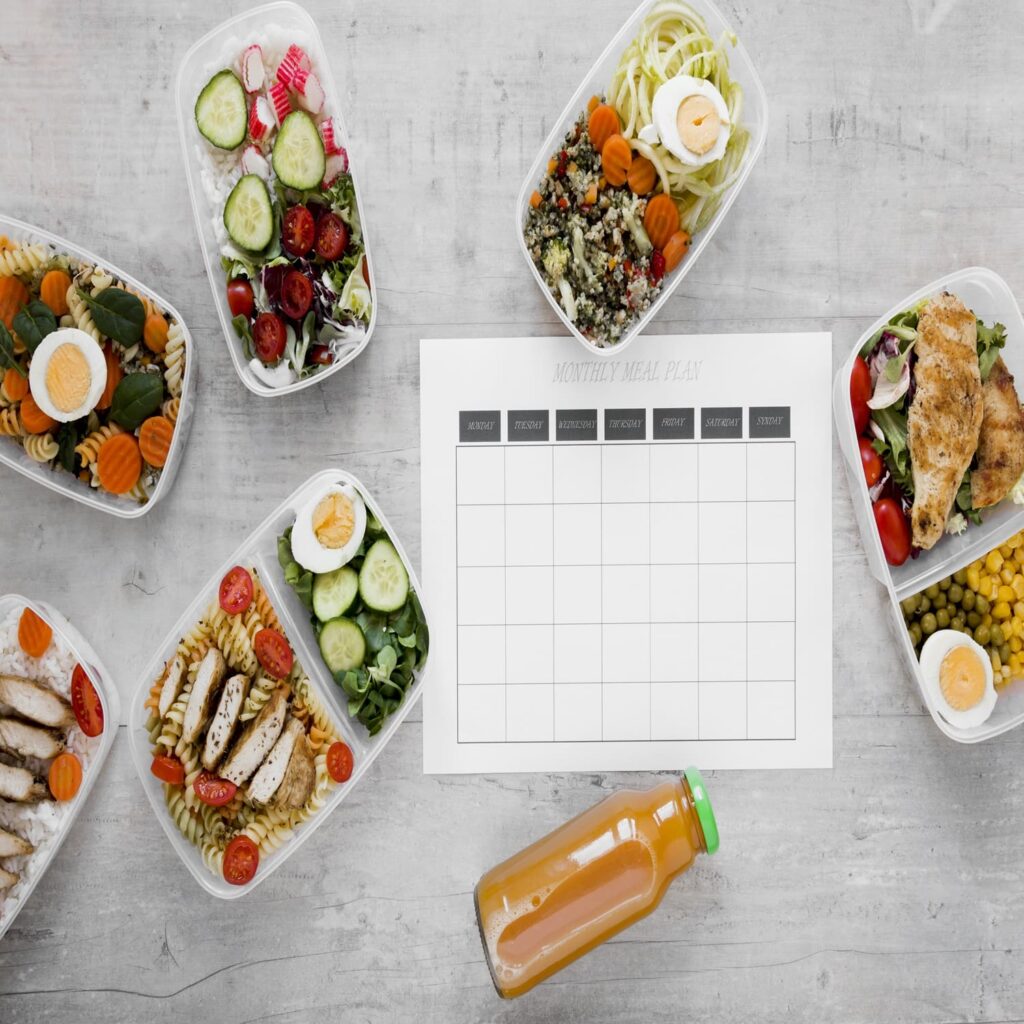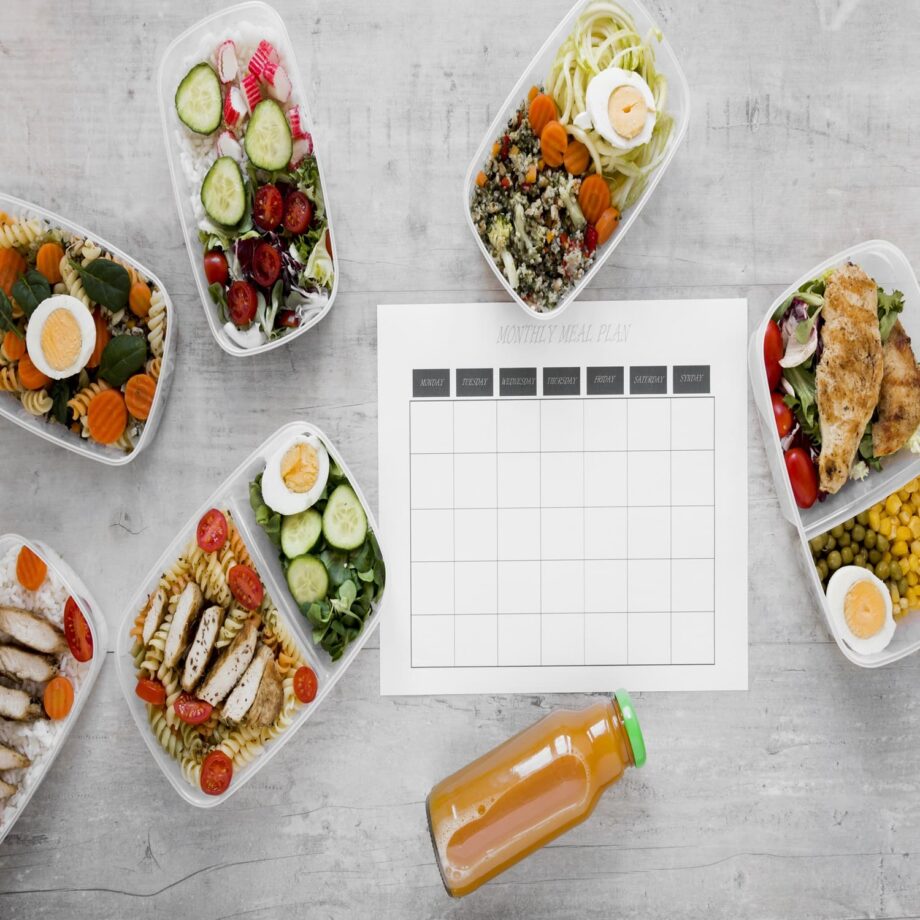Learn how to meal prep for a week with easy, healthy, and time-saving recipes. Plan, cook, and store balanced meals to stay organized, eat nutritious food, and save money.

Weekly meal planning may seem daunting at first, but with the correct strategy, advice, and resources, you can eat better, save time, and feel less stressed when it comes to mealtimes. Whether you’re a parent, student, or busy professional, learning how to prepare meals for the week can change your diet and way of life.
Why Meal Prep is Important ?
One of the best ways to save time and maintain a healthy eating routine is to learn how to prepare meals for the coming week. Meal planning is more than just preparing meals ahead of time; it’s about developing a structured, stress-free approach to nutrition that complements your objectives and way of life.
The Main Advantages of Meal Planning
Conserve time and energy.
Daily cooking stress is eliminated when meals are prepared in advance. You can enjoy quick, ready-to-eat meals every day by cooking grains, proteins, and vegetables in bulk once a week. This frees up time for family activities, work, or exercise.
Limit Your Portion Size and Prevent Overindulging
Overeating or mindless snacking can be avoided with pre-portioned meals. You can maintain consistency with healthy eating, support weight goals, and better manage calories by planning how much to eat in advance.
Consume Fresh, Balanced Meals to Eat Healthier
Making your meals in advance guarantees that your week will contain nutrient-dense foods like whole grains, lean meats, and fresh vegetables. This method promotes healthy, balanced meals that maintain steady energy levels and fuel your body.
Cut Down on Food Waste
You can use ingredients more effectively if you plan and prepare meals in advance. Purchasing in bulk and arranging leftovers into your weekly schedule reduces waste and conserves resources and money.
Conserve funds.
By meal planning, you can avoid last-minute takeout, buy in bulk, and take advantage of seasonal produce. This can drastically lower your grocery and dining costs over time.
🥕 Step 1: Plan Your Meals
Planning your meals ahead of time is the first step in learning how to meal prep for a week. Your week will be stress-free, balanced, and well-organized if you take the time to plan out your breakfast, lunch, dinner, and snacks.
🍳 Breakfast Ideas
Start your day strong with nutritious and easy-to-prepare breakfasts:
- Overnight oats with fresh fruit and nuts
- Smoothie packs prepped in advance for quick blending
- Egg muffins baked with vegetables and herbs
🥗 Lunch Ideas
For lunches that are both filling and healthy, consider:
- Grain bowls with quinoa, brown rice, or couscous, paired with vegetables and protein
- Fresh salads with chickpeas, beans, or grilled chicken
- Wraps using whole-grain tortillas and seasonal vegetables
🍲 Dinner Ideas
Dinner can be simple yet satisfying:
- Stir-fries with fresh vegetables and your choice of protein
- Roasted vegetables with chicken, fish, or tofu
- Sheet-pan meals for easy cooking and minimal cleanup
🥜 Snacks
Keep healthy snacks ready to avoid unhealthy temptations:
- Nuts and seeds for protein and healthy fats
- Cut vegetables for easy grab-and-go options
- Yogurt or fruit for a refreshing, nutritious treat
🛒 Step 2: Make a Grocery List
Making a thorough grocery list is the next crucial step in how to meal prep for a week after you’ve planned your meals. A well-thought-out list helps you stick to your meal prep plan, minimizes needless trips to the store, and guarantees you buy everything you need for the week.
Purchasing fresh, in-season ingredients at your neighborhood market or grocery store enhances the taste of your food while optimizing its nutritional content. Compared to out-of-season products, seasonal produce is frequently more reasonably priced and has a higher vitamin and mineral content.
🥦 What to Include in Your Grocery List
- Fresh vegetables and fruits – choose colorful, in-season options to make your meals vibrant and nutrient-rich. Examples: spinach, bell peppers, tomatoes, berries, apples.
- Whole grains – such as quinoa, brown rice, oats, or whole-grain pasta for sustained energy and fiber.
- Proteins – include lean and versatile options like chicken, fish, tofu, beans, or lentils to support muscle repair and satiety.
- Healthy fats – add avocado, olive oil, nuts, and seeds to enhance flavor and provide essential fatty acids.
💡 Grocery List Tips for Meal Prep
- Check what you already have to avoid buying duplicates
- Buy in bulk for grains and proteins to save money
- Prioritize versatile ingredients that can be used in multiple recipes
- Don’t forget herbs and spices – they enhance flavor without extra calories
🍳 Step 3: Cook Efficiently
Cooking effectively is the next step in how to meal prep for a week after you have your grocery list and meal plan. You can save time during your hectic week by preparing several meals at once by designating a specific day for batch cooking, usually Sunday or any day off.
🔹 Advice for Effective Cooking
Prepare grains in big quantities.
Make large quantities of quinoa, brown rice, or oats. To use them for several meals throughout the week, keep them in airtight containers.
Vegetables can be roasted or steamed.
Seasonal vegetables are adaptable for stir-fries, salads, wraps, and grain bowls when they are roasted or steamed in large quantities. By using this technique, natural flavors are enhanced and nutrients are preserved.
Prepare the proteins in advance.
Prepare proteins such as fish, poultry, tofu, or beans ahead of time. To keep them adaptable for a variety of meals, season them simply. This guarantees that a protein source is always available for use.
When portioning, use storage containers.
To portion meals for each day, purchase airtight containers. Preparing meals in advance guarantees appropriate portion control, minimizes waste, and facilitates mealtime grab-and-go.
🥡 Step 4: Store Meals Properly
The next crucial step in meal prep for a week is properly storing your cooked meals. Effective and convenient meal prep is made possible by proper storage, which guarantees that your food will remain tasty, fresh, and safe to consume throughout the week.
🔹 Advice for Appropriate Food Storage
Make use of airtight containers.
Purchase premium, airtight containers to prolong the freshness of meals and stop moisture loss. Vegetables, grains, and proteins store well in glass or BPA-free plastic containers.
Put dates on food labels.
Label containers with the date of preparation to maintain freshness. This keeps food from spoiling and helps you eat meals in a timely manner.
Keep ingredients and snacks apart.
To preserve texture and avoid sogginess, keep things like chopped fruits, vegetables, or crunchy toppings apart from wet ingredients.
Freezer vs. Fridge
Meals that you intend to consume within three to four days should be refrigerated.
The remaining meals can be frozen for a later time of day. For grains, proteins, and cooked vegetables, freezing works best because it prolongs freshness without sacrificing flavor.
💡 Step 5: Tips for Successful Meal Prep
Weekly meal prep can be made simpler, more pleasurable, and more sustainable with a few useful tips, even after you’ve planned, prepared, and stored your meals. By using these techniques, you can maintain a healthy diet without feeling overburdened.
Keep It Easy
For the week, start with two or three different meals and switch them up. This shortens the cooking time, minimizes cleanup, and facilitates consistency maintenance. Particularly if you’re new to meal planning, simplicity is essential.
Prepare Snacks Ahead of Time
For convenient grab-and-go snacks, chop fruits, vegetables, and portion out nuts. Keeping wholesome snacks on hand helps you avoid bad cravings and maintain consistent energy levels throughout the day.
🔹 Combine Different Ingredients
By mixing ingredients in different ways every day, you can prevent boredom. Proteins can be switched between meals, and roasted veggies can be added to salads, grain bowls, or wraps. This keeps your weekly menu interesting and varied.
Make Use of Spices and Herbs
Improve flavor organically without consuming additional salt or calories. Simple ingredients can be made into delectable, flavorful meals with the help of herbs like parsley, basil, cilantro, and spices like cumin, paprika, or turmeric.
Planning your meals in advance doesn’t have to be complicated. If you’re looking for inspiration on what to include in your meal prep, check out our guide on healthy lunch ideas using local market finds. These recipes are not only nutritious but also easy to prepare in bulk. For more practical tips on making your meal prep even simpler and delicious, see our full article on healthy food prep lunch ideas: easy, delicious, and perfect for busy days
If you’re looking for more expert advice and creative meal prep ideas, check out this detailed guide from Good Housekeeping on how to meal prep efficiently

